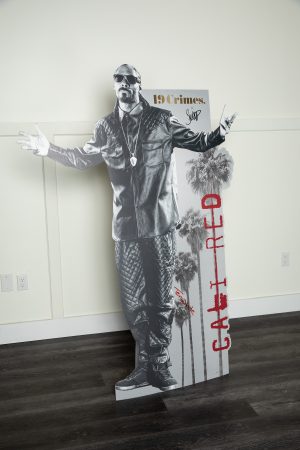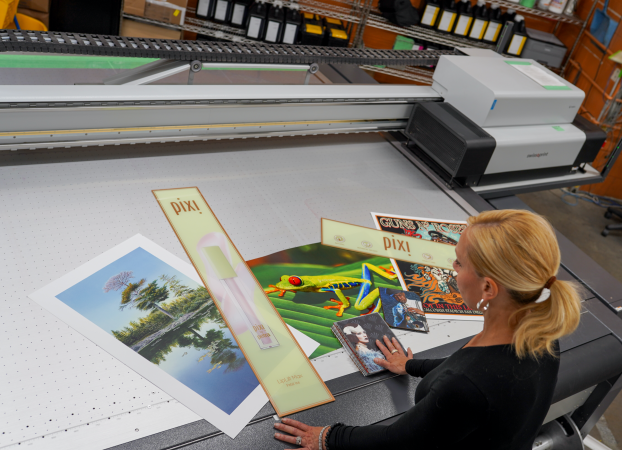
Features
In-Depth
Profiles
Women in Manufacturing
Reluctant no more
Once a reluctant president, Carla Johanns has now embraced the role as the head of Simpson Print
January 4, 2022 By Nithya Caleb

In 2012, when Carla Johanns, president of Simpson Print, Bloomingdale, Ont., moved back into her parent’s home to support a grieving family and stabilize a struggling business due to the tragic death of her brother, she didn’t realize that her life had indefinitely changed.
Carla, a single mother of two girls at that time, was living in Niagara, Ont., and pursuing a master’s degree. Carla never imagined that one day she would be leading the family business. However, the death of her younger brother, who was the company’s principal shareholder then, propelled Carla into unchartered waters.
“We lost almost $3 million in 90 days. I sat in the hallway and did what comes naturally: sell,” recalls Carla, who was always involved in sales in some capacity throughout her professional life.
In a hyper-competitive market, Carla, a goal-oriented individual, managed to successfully turn around the business. Simpson Print posted a profit of $9.7 million last year. This year, it earned $13.1 million. Carla is forecasting a revenue of $15 million for the next fiscal year.
After almost 10 years, Carla is no longer the “reluctant” president of Simpson Print. The 49-year-old has embraced her role as the company’s executive head, and has ambitious plans for the printing business. She also owns 25 per cent of the company’s shares.
About Simpson Print
Simpson Print is known for integrating art effects, coatings and unique finishes with special effects and embellishments on diverse and unusual substrates.
“We’re very substrate-savvy. We’re great at merchandising, metallic packaging, obscure postpress, diecutting and finishing, and managing budgets for a Cadillac end-result,” explains Carla.
The urban legend
Carla’s father, Martin Johanns, is the minority shareholder, chair and founder of Simpson Print. An immigrant from the Netherlands and an aspiring arborist, he discovered his entrepreneurial calling in offset printing.
In 1964, he began a company called Johanns Graphics. This was the heyday of conventional Renaissance printing of annual reports and magazines. Carla remembers watching designers working on storyboards in a 1,000-sf room.
“My father is an extremely passionate ambassador of ink on paper and the craft of print. His enthusiasm and think-ahead mentality carry us even today,” says Carla.
Even though the company was successful, technological changes, such as the introduction of desktop publishing and elimination of film, were starting to emerge. Martin sold the company before the economic crash of 1990.
Two years later, Carla’s mother, Maddy, found, in the middle of another farm field, a screen printing company called Simpson Screen Printing with one client, MTD. The company made $1.3 million in sales of label identification on lawnmowers and other industrial applications.
As an early adopter of an increasingly popular technology, Simpson Screen Printing began to grow. It soon had US clients so much so that 70 per cent of its customers resided south of the border.
In 1994, when Martin’s old offset company went into receivership, he bought it along with the building where Simpson Print is currently located.
Diverse offerings
Carla believes Simpson Print’s biggest strength is diversity.
“I don’t see myself as a screen printer or a digital printer. I view us as an all-under-one-roof print manufacturing and merchandising solutions provider,” says Carla. “Our business is very diverse. Forty per cent of our business is industrial nameplate identification. Another 40 per cent is wide-format solutions from custom through in-store signage programs, and then we have offset, which is actually doing remarkably well. The name of the game is to be diverse,” says Carla.
The company has the capabilities to print spot colour face down; UV litho print with spot UV screen print with specialty inks; different touches, such as textured, powdered and soft; clear; sparkle; tinted; glitter; raised clear with glitter; screen print spot matte; and digital print on vinyl, plastic or paper. It can also do custom diecut, folding, embossing, shrink wrapping, laminating, grometting, hemming, drilling, heat bending, heated platen diecutting, gloss coating and spot reticulation.
“We’re not in the business of conventional prints. When others say no, we say yes. We offer multiple products. We offer still high-resolution screen prints and have an extensive line of wide-formats, digital and UV offset and finishing solutions. In the last few years, I invested around $3 million in new technology and capitol investments. The print industry is capitol intensive, and I do not believe you can remain relevant if you are not continually investing,” adds Carla.
SwissQprint as partners
Simpson print is proud to have two screen printers while everybody is eliminating their screen presses. They’re also the largest Canadian client of SwissQprint, which is very dominant in Europe.
“SwissQprint is easy to maintain. I spend $14,000 on maintenance on three SwissQs, and they contribute to 75 per cent of my bottom line. SwissQ is also the most versatile press. They all have varnishes and primers, which means I can print on an unusual amount of substrate, such as tempered glass, building materials, laminate flooring, wood, aluminum and polyethylene. Since it has UV-LED, it is significantly reducing a project’s carbon footprint. It limits the conventional, heavy screen deposit. The fact that I have three of them ensures that I can do small, multiple or 5,000 sheet jobs with an in-store deadline of 24 hours,” explains Carla.
Sustainability
As someone who was taught to work hard and use sustainable practices in all walks of life, Carla is keen on adopting eco-friendly principles in the business.
“Print is naturally a very toxic industry. It generates a lot of waste. In the early days, we used recycling ponds at the cost of $14,000 to $20,000 monthly to decontaminate water. We also looked at living walls to control dust. We’ve been thinking green because it’s not just about marketing and the end product, but also being lean in our manufacturing workflow by adopting automation. When you’re lean in your manufacturing principles, you’re passing on savings to your customers,” she says.
Pandemic’s impact
Carla admits having many sleepless nights in the initial days of the pandemic, but the company was able to pivot quickly.
While some of their clients (e.g. event organizers) didn’t need printing services, others increased their orders. Simpson Print’s label business increased by 20 per cent, and it is still growing.
Carla attributes this resiliency to the fact that the company has seen many ups and downs, especially a big one (the death of its principal shareholder) in 2012, so it was able to navigate the pandemic pretty well. It also helped that Simpson Print offers diverse solutions.
“Post-COVID, you’ve got to go back to the basics of great pressing and quality, and on time execution. We recognize it’s going to be the Wild West domestically. [Thankfully] our business is now evenly spread between Canada and the US,” says Carla.
Future plans
Carla’s main focus is restructuring the company including finance and operations and maintaining strategic growth either organically or through “sensible US acquisitions.” Carla is also keen on enhancing the company’s digital marketing capabilities so as to complement its print services.
As indicated earlier, Carla has expanded the company’s inventory to maximize potential and take on new projects. She’s also expanding space in her print plant by another 20 million sf. “I see my fulfillment and warehouse businesses significantly increasing,” adds Carla.
Since Simpson has been in the printing business for 16 years, Carla feels it’s critical for the company to be leaders in innovation and sustainability as well as to champion the importance of print as a marketing channel.
Carla believes the industry would soon be shifting focus from the need for speed to software that increase workflow automation.
“The beauty of the industry is you have to commit to change. You have to be creative,” says Carla. Her ambition is to make Simpson Print “omni marketing intelligent.”
As she explains, “You cannot install a press and deliver value; you have to build all silos of the business to be better and to drive innovative solutions that work with your customers. Print is no longer just about placing ink on paper; it is about the pre- and post-show.”
Print this page


